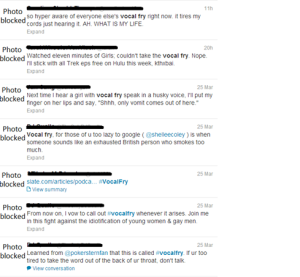I suspect those who are interested in a blog like mine have likely heard about the story of a supposed sign language interpreter for Nelson Mandela’s funeral in South Africa. However, here’s a short summary: a man (Thamsanqa Jantjie) hired to do sign language interpretation completely mangled the job, and infuriated many deaf people who wished to watch the events and pay their respects to Mandela.
Although there are many intriguing aspects to the story, including the interpreter’s claim that he suffered a schizophrenic episode, and the gruesome story of his burning two men to death, I want to talk about something that has tended to get lost in the discussion in the mainstream: the deaf people who wished to witness the tributes to a great man, and were robbed of that because their government paid a “bargain rate” for the services of a fraud sign language interpreter. Mainstream news media may make mention of the “outrage” of the deaf community, but that is a one-sentence nod to the community, whose story it is in the first place. Some people even find the story amusing, as can be seen by the SNL parody of the event.
I think that a particularly apt example of just how little the mainstream media cares about this linguistic minority is White House spokesperson Josh Earnest’s response to the situation: “It’s a shame that you had a service that was dedicated to honoring the life and celebrating the legacy of one of the great leaders of the 20th century has gotten distracted by this and a couple of other issues that are far less important than the legacy of Nelson Mandela.”
The other issues, mentioned in the article linked above, are the Obama selfie and the Obama-Castro handshake, which are by most accounts incredibly trivial. I am not saying that the legacy of Nelson Mandela doesn’t outshine many issues of varying sizes, but to compare the lack of respect for the deaf demonstrated in this hiring choice to a selfie is beyond insulting.
The deaf community and deaf blogs, on the other hand, tell a more complete story of the reactions of signers worldwide to the “terp” (a nickname for interpreters used on deaf blogs). In a statement, the National Director of the Deaf Federation of South Africa, Bruno Druchen said the following:
“The so called “interpreter” who interpreted at the Official memorial service for late former president Nelson Mandela at FNB stadium has been dubbed the “fake interpreter” and the Deaf community is in outrage. This man is not in fact a recognised, professional South Sign Language Interpreter. He is not known by the Deaf Community in South Africa nor by the South African Sign Language interpreters working in the field… This ‘fake interpreter’ has made a mockery of South African Sign Language and has disgraced the South African Sign Language interpreting profession. The organisers of the memorial service, and indeed any event, should have contacted organisations who coordinate South African Sign Language interpreting services to secure a professional, trained experienced interpreter.”
But I think perhaps my favorite commentary is the following statement from the Michigan Department of Civil Rights Division of Deaf and Hearing, from Sheryl Emery.
“It is an insult to people who utilize sign language, to skilled interpreters, and to the legacy of a man whose entire life’s work was based on equality and fair treatment for all people. Sign language is a human right. Every deaf, hard-of-hearing, and deaf-blind person deserves the right to communicate, to be understood, and to understand others.” (emphasis mine)
See the entire video of her statement here.




